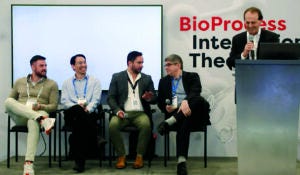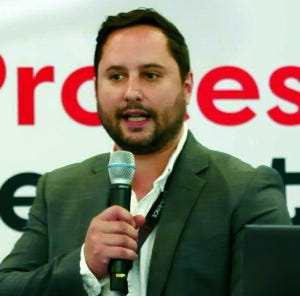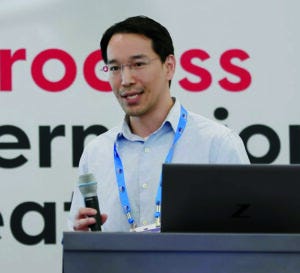- Sponsored Content
- Information Technology
Adoption of New Biopharmaceutical Technologies: Case Studies from the Front Line
Sponsored by Kaleidoscope Bio

Moderator Tom Ransohoff (principal, RTI Consulting), with (left to right) Bogdan Knezevic (cofounder and CEO of Kaleidoscope Bio), Kevin Lee (head of CGT and bioprocess applications development, MilliporeSigma), Aaron Larsen (technical head of the nucleic-acid franchise, Resilience), and Oleg Shinkazh (cofounder and CEO, ChromaTan).
Moderator Tom Ransohoff welcomed the panelists and offered some opening remarks. Ransohoff is principal at RTI consulting, supporting biopharmaceutical companies, bioprocess technology developers, and investors. He held previous positions as co-head of the biologicals franchise at Resilience, as vice president and senior consultant at BioProcess Technology Consultants, Inc., then as managing director of BDO USA, LLP. His experiences span much of the history of the modern biopharmaceutical industry, always at the forefront of new technologies and modalities, beginning his career as a process engineer at XOMA in 1986, then moving to positions at Dorr-Oliver, Repligen, Dyax, and TranXenoGen.
Ransohoff introduced his session by emphasizing that adopting new technologies is critical to the health and ongoing success of our industry, yet doing so is a challenging and lengthy process. He spoke of the successful adoption of single-use bioreactors as one example. The first single-use bioreactor was introduced in 1999 by Wave Technologies, but 15 years passed before single-use bioreactors had gone through the complete adoption cycle. By contrast, the first iPhone and Android phones were introduced in 2007. In just a few years, it was hard to find anyone still using a flip phone or a Blackberry.
He noted that despite the good reasons our industry has for taking longer than others to adopt new technologies, we can’t help wondering how we could do it better. He asked, “What are some of the things that we have to consider as innovators when developing businesses based on new technologies to ensure the best chance of success?”
All four panelists have been deeply engaged in bringing new technologies to the market. Ransohoff invited each panelist to summarize technologies of special interest and one or two lessons learned around the adoption process.

Bogdan Knezevic
Kaleidoscope Bio
Bogdan Knezevic is cofounder and CEO of Kaleidoscope Bio. Knezevic previously worked as a scientist and struggled with the challenges of insufficient software in the R&D space. So his experiences span both academia and the private sector. He completed his PhD in genomics and preclinical drug discovery at Oxford University, where he was awarded a Rhodes scholarship.
Knezevic introduced Kaleidoscope as a decision and collaboration player that helps companies assess data that they generate about any small-molecule sequence, protein, or antibody. The company helps clients develop project-management systems and to automate tasks they don’t want to perform manually.
Knezevic identified three questions that Kaleidoscope addresses when meeting customer needs: whether to build or buy software, how to budget for software and software licenses, and how to secure a competitive advantage through data stewardship from the start of process development. He emphasized that “taking data hygiene and data stewardship seriously from the beginning” is one of the best things that a company can do to invest in its future — not just to ensure reproducibility in the short term, but also to prepare for eventual regulatory submissions.
His final point was that artificial intelligence (AI) and machine learning (ML) must be leveraged such that data are accessible to scientists in the first place. His outlined elements for working with customers. First, Kaleidoscope ensures alignment of its offerings with customer needs, identifying end users who will benefit most from such tools. A second goal is to offer a demo with engineering, product, and science teams. A third element is to define a “bite-sized pilot” to demonstrate to a client the value of the software over a three-month period. Finally, Kaleidoscope and the client base long-term decisions around annual and multiyear contracts off of that value.

Aaron Larsen
Resilience
Aaron Larsen began studying RNA in 2012 where he was a postdoc in Jack Szostak’s lab at Harvard University. After that, he joined Moderna and Beam Therapeutics before coming to Resilience. He leads the nucleic-acid franchise, where he’s responsible for enabling new technologies to build better biomanufacturing platforms in that field.
Resilience was founded about three years ago with the aim of making the world more resilient against future pandemics. It partners with academic laboratories, industry (both biotech and big pharma), and governments to bring them best-in-class modalities. Resilience has 13 sites and networks across the United States, Canada, and now in the United Arab Emirates and is expanding into Europe and other areas. The nucleic-acid franchise employs 2,400 people/scientists across five sites. R&D work is performed in Waltham, MA; production takes place at the Toronto Canada, facility; and drug substance is produced at the Cincinnati, OH, facility for liquid nanoparticle (LNP) formulation, which is colocalized with fill–finish capabilities. Larsen added that Resilience also is ramping up guide-RNA production for gene-editing purposes and is partnering with suppliers of good manufacturing practice (GMP)–grade materials to create gene-editing guides.
He provided examples of company services, including performing qualified and validated release assays. The company is developing new assays and exploring new process enzymes. “We’ll push the science as far forward as possible to make the best possible mRNA.” His slides showed an example process for a commercially available vaccine using a modular platform.

Kevin Lee
MilliporeSigma
Kevin Lee cofounded Erbi (now part of MilliporeSigma) in 2011 after helping develop a core technology platform as part of his doctoral research at the Massachusetts Institute of Technology (MIT). Ransohoff attested to Lee’s expertise in “every aspect of microbioreactor technology.” Lee earned his bachelor degree in electrical engineering from the University of California at Los Angeles (UCLA) and his PhD from MIT.
Before its recent acquisition, Erbi was a 30-person start-up company focused on making capital equipment for small-scale perfusion processes. It made a scale-down predictive tool to intensify perfusion development. Lee summarized technologies and products available to a pharmaceutical company developing an upstream process from transfection through scale-up — mainly for perfusion processes.
The technology takes the form of a small-scale microbioreactor platform of four independently controlled bioreactors operating at a 2-mL scale. He described the microbioreactor as having “the size and volume that you would expect from a well-plate, but with all the control and capability [you] would expect from a thousand-times larger stirred tank.” All functional elements of the stirred tank are miniaturized using microfluidics in a consumable, disposable cartridge, enabling a process that is highly integratable and automatable. The upstream application space has many steps, so the company chose to focus on late-stage perfusion cell-line development, media screening optimization, and early process development. What was missing, said Lee, was technology “in the middle” to reduce the amount of work at both ends of a process. His group encourages out-of-the-box thinking to adopt a supplemental tool to help change a workflow rather than replace an element within it.
Lee noted that, when faced with new technology, many groups don’t fully understand their process and what will happen when they change “even the smallest thing.” Lee’s group meets them “halfway” by building out infrastructure and offering educational demonstrations.

Oleg Shinkazh
ChromaTan
The fourth panelist, Oleg Shinkazh, is founder of ChromaTan and an inventor of countercurrent tangential chromatography. Shinkazh is a chemical engineer and biotechnology entrepreneur with more than 20 years of experience in R&D and technical support in the biotechnology industry, specializing in downstream processing and purification.
ChromaTan is an early phase company, in which 20 employees are focused exclusively on developing continuous countercurrent tangential chromatography (CCTC), a column-free purification platform targeting cell and gene therapy markets, specifically AAV and lentiviral purification. The technology operates with the same chemistries that are used in column processes (e.g., the same buffers and resins), enabling significant advantages.
Shinkazh described how resin is taken out and suspended in a slurry instead of being packed into a column. The slurry is cycled rapidly through the chromatographic operational stages simultaneously, basically forming a disposable flow path. As the product reaches the elution step, it comes off at a steady-state concentration that’s dialed in and predictable.
He showed comparative data on the process compared with those of column- and multicolumn–based processes. Without columns, the process residence time is an order of magnitude lower, and elution occurs in less than a minute. CCTC runs at low pressures and allows users to adjust a product in line. The process can decrease the amount of resin that is used per gram of product produced — sometimes by >90%. He illustrated how the technology works using an example gene-therapy application and a case study with Eli Lilly that improved recovery during an antibody purification process.
Discussion (Q&A)
Ransohoff: What are you looking for in customers, collaborators, and early adopters for new technologies? How can they help with the process?
The panelists agreed on several criteria. The first point was that a customer or collaborator has to have a program in place that motivates its staff to implement innovation. Another point was the importance of working with people who are problem-focused, not solution-focused. That enables a technology provider to demonstrate features specific to a problem the customer is trying to solve. The goal is to collaborate with people who are risk-tolerant enough to work through the inevitable “hiccups” presented by a new technology. Finally, customer/collaborator flexibility is important: If a customer’s process is not functional, then that customer needs to be open to receiving input to change it.
Ransohoff:How do you identify the best applications for new technology? With many new technologies, there are large numbers of potential applications. How do you home in on the ones that are the highest-value applications?
Shinkazh noted the importance, early on, of a shared commercial vision of GMP manufacturing. The right application must present a sort of orthogonal benefit. “Is it enough to just have an economic benefit for applying new technology in clinical production? Probably not. But if [a new chromatography process, e.g.] can bring economic benefit and increase purity and recovery, that becomes very attractive. So we’re looking for multiple benefits.”
Larsen said that mRNA applications are “absolutely everywhere. I haven’t seen a disease yet where we can’t move the needle with mRNA, from infectious disease all the way to cancer and everything in between. So, honestly, bring us your challenge, and we’ll find an application for mRNA in your technology.”
Lee commented on the economic benefit of building software for types of operations that companies are putting money into rather than trying to sell them on predeveloped systems. And Knezevic emphasized the importance of offering a competitive advantage rather than only a monetary benefit. Ransohoff agreed, adding that incremental improvements and changes are difficult and expensive, so early adopters expect more than an incremental improvement.
Audience Member:How do you properly incentivize new adopters to take that first step to evaluate the feasibility of a technology, especially if they already might have processes in place?
The panelists offered a number of responses, agreeing that although many larger companies have innovation teams that are open to evaluating new technology, they may not have the time or resources to evaluate a demonstration. This point emphasized the importance of collaborating with a service or technology provider that can run through a method with them a few times. Another approach is to learn how a customer’s process works/operates currently and how it could be improved. The service provider then can set up a workspace, configure the process, take in some sample data, and then with various tweaks as necessary, offer the customer a new approach. In short, the provider assumes a certain amount of risk to model a new process before a client makes the big decision to sign a contract.
Shinkazh said that “at ChromaTan we have set up a framework for R&D contracts. People don’t have to buy our system, get trained, and invest [labor time] right up front to figure out how our technology works. We’ll execute a material transfer agreement with them, run their product in our lab, and basically train them in our lab, producing detailed results and collaborating with our analytical department to generate purification samples. We basically characterize the entire thing in and out without their paying for capital equipment upfront.
Ransohoff:Thinking broadly, what change in industry could improve the way that we adopt new technology? How we might improve the process overall?
The panel’s responses summarized much of the previous discussion and suggested ways forward.
• Incentivize people to adopt new technologies and decrease their risk to protect them against failures.
• Approach clients by questioning whether there’s a better process rather than suggesting that they swap out an element that they already have; help them be open to a new solution.
• Expand applications of new modalities to address massive indication spaces that companies are ignoring.
• Encourage companies to put more value into collaboration and to reduce legal and other barriers to such partnering — which is especially important to start-up companies.
Fill out the form below to view the full roundtable discussion now.
You May Also Like





